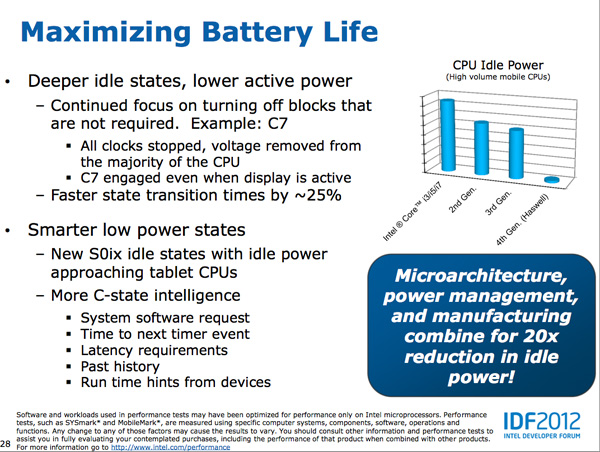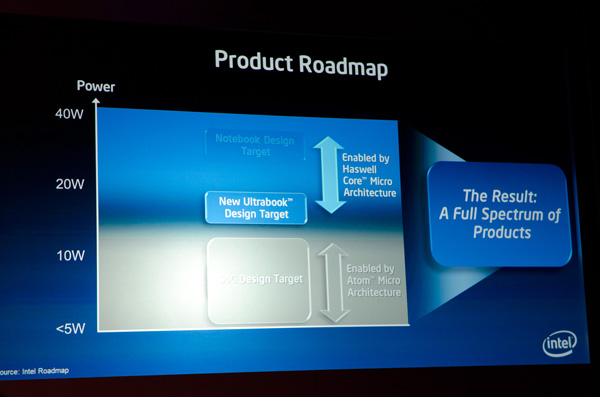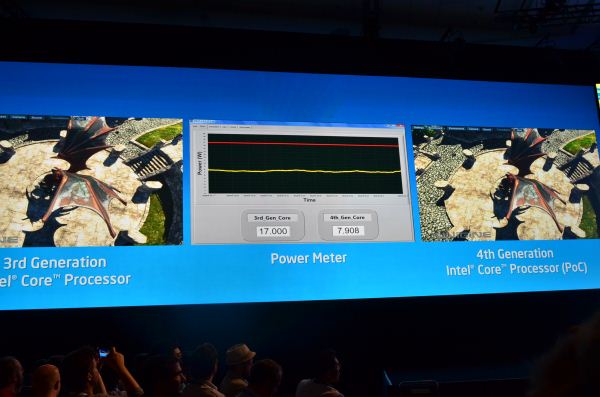Intel's Haswell Architecture Analyzed: Building a New PC and a New Intel
by Anand Lal Shimpi on October 5, 2012 2:45 AM ESTOther Power Savings
Haswell's power savings come from three sources, all of which are equally important. We already went over the most unique: Intel's focus on reducing total platform power consumption by paying attention to everything else on the motherboard (third party controllers, voltage regulation, etc...). The other two sources of power savings are more traditional, but still very significant.

At the micro-architecture level Intel added more power gating and low power modes to Haswell. The additional power gating gives the power control unit (PCU) more fine grained control over shutting off parts of the core that aren't used. Intel published a relatively meaningless graph showing idle power for standard voltage mobile Haswell compared to the previous three generations of Core processors.
Haswell can also transition between power states approximately 25% faster than Ivy Bridge, which lets the PCU be a bit more aggressive in which power state it selects since the penalty of coming out of it is appreciably lower. It's important to put the timing of all of this in perspective. Putting the CPU cores to sleep and removing voltage/power from them even for a matter of milliseconds adds up to the sort of savings necessary to really enable the sort of always-on, always-connected behavior Haswell based systems are expected to deliver.
Intel has also done a lot of work at the process level to bring Haswell's power consumption down. As a tock, Haswell is the second micro-architecture to use Intel's new 22nm tri-gate transistors. The learnings from Ivy Bridge are thus all poured into Haswell. Intel wasn't too specific on what it did on the manufacturing side to help drive power down in Haswell other than to say that a non-insignificant amount of work came from the fabs.
The Fourth Haswell
At Computex Intel's Mooly Eden showed off this slide that positioned Haswell as a 15-20W part, while Atom based SoCs would scale up to 10W and perhaps beyond:
Just before this year's IDF Intel claimed that Haswell ULT would start at 10W, down from 17W in Sandy/Ivy Bridge. Finally, at IDF Intel showed a demo of Haswell running the Unigen Heaven benchmark at under 8W:
The chain of events tells us two things: 1) Intel likes to play its cards close to its chest, and 2) the sub-10W space won't be serviced by Atom exclusively.
Intel said Haswell can scale below 10W, but it didn't provide a lower bound. It's too much to assume Haswell would go into a phone, but once you get to the 8W point and look south you open yourself up to fitting into things the size of a third generation iPad. Move to 14nm, 10nm and beyond then it becomes more feasible that you could fit this class of architecture into something even more portable.
Intel is being very tight lipped about the fourth client Haswell (remember the first three were desktop, mobile and ultra-low-volt/Ultrabook) but it's clear that it has real aspirations to use it in a space traditionally reserved for ARM or Atom SoCs.
One of the first things I ever heard about Haswell was that it was Intel's solution to the ARM problem. I don't believe a 10W notebook is going to do anything to the ARM problem, but a sub-8W Haswell in an iPad 3 form factor could be very compelling. Haswell won't be fanless, but Broadwell (14nm) could be. And that could be a real solution to the ARM problem, at least outside of a phone.
As I said before, I don't see Haswell making it into a phone but that's not to say a future derivative on a lower power process wouldn't.













245 Comments
View All Comments
TeXWiller - Friday, October 5, 2012 - link
Perhaps they also try to reach lower usable clock frequencies through performance upgrades and this way gain some additional voltage scaling, or what is left of it.vegemeister - Saturday, October 6, 2012 - link
>think loop counters which store an INT for loop iteration then perform some FP calcsIf updating the loop counter us taking a substantial fraction of the CPU time, doesn't that mean the compiler should have unrolled more?
Anand Lal Shimpi - Friday, October 5, 2012 - link
The high end desktop space was abandoned quite a while ago. The LGA-2011/Extreme platform remains as a way to somewhat address the market, but I think in reality many of those users simply shifted their sights downward with regards to TDPs. A good friend of mine actually opted for an S-series Ivy Bridge part when building his gaming mini-ITX PC because he wanted a cooler running system in addition to great performance.To specifically answer your question though - the common thread since Conroe/Merom was this belief that designing for power efficiency actually means designing for performance. All architectures since Merom have really been mobile focused, with versions built for the desktop. I like to think that desktop performance has continued to progress at a reasonable rate despite that, pretty much for the reason I just outlined.
Take care,
Anand
csroc - Friday, October 5, 2012 - link
Sandy Bridge E just seems to price itself out of being reasonable for a lot of people. The boards in particular are rather steep as well.dishayu - Friday, October 5, 2012 - link
Well, LGA2011 is bit of a halo product with no real substance. An ivy bridge 3770K will stand up to a quad core LGA2011 part nicely, not to mention it supports PCI e gen3, so even though it has lesser lanes, it doesn't have a bandwidth disadvantage. Moreover LGA2011 is still stuck at sandy based architecture, so that again isn't quite on the bleeding edge and as far as i understand, Haswell will come out before IB-E does, so it's 2 full cycles behind.Kevin G - Friday, October 5, 2012 - link
For a single discrete GPU, Ivy Bridge would be able to match the bandwidth of Sandy Bridge-E: a single 16 lane PCI-E 3.0 connection. Things get interesting when you scale the number of GPU's. There is a small but clear advantage to Sandy Bridge-E in a four GPU configuration. Ivy Bridge having fewer lanes does make a difference in such high end scenarios.For its target market (mobile, low end desktop), Ivy Bridge is 'good enough'.
vegemeister - Saturday, October 6, 2012 - link
Quad core LGA2011 is kind of a waste though. If you're already paying extra for the socket, my philosophy is go hexcore and 8 DIMMs or go home.Peanutsrevenge - Friday, October 5, 2012 - link
Given that desktop software's not really been pushing for better CPU performance, the direction intel has taken is not a bad one IMO either.It's now possible to build a mighty gaming rig in an mITX case (Bit Fenix Prodigy), think 3770K and GTX 690 gfx and watercooled.
A rig like that will likely last 3 years before settings have to be tweaked to keep 60+ fps.
What's really needed is for software to take advantage of GPUs more, (which would play into AMDs hands), but I fear many of the best coders have switched from windows to Android/iOS development, With windows 8 shipping shortly, that number will increase further.
j_newbie - Saturday, October 6, 2012 - link
I think that is quite sad.I for one always need more FLOPS, MCAD work and simulation work depends on two things memory bandwidth+size and flops, surprisingly AMD still offers a better vfm deal in this space thanks to avx instructions not being widely adopted into most FEA/CFD code yet and the additional ram slots you get with cheaper boards.
Server components are always overpriced as we dont need a system to last very long.
my 3930k setup is about 1.5 times faster than the x6 setup at 3 times the cost... :(
Peanutsrevenge - Saturday, October 6, 2012 - link
You're talking more of a workstation than a desktop. Hence my use of the word 'desktop'.